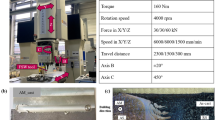Abstract
Fusion welding processes are widely used to assemble large thin plate structures such as ships, automobiles, and passenger trains because of their high productivity. However, welding-induced distortion often inevitably occurs during the assembly process. Welding distortion not only reduces the fabrication accuracy of a welded structure but also decreases productivity due to correction works. If welding distortion can be predicted using a practical method beforehand, the prediction will be helpful for taking appropriate measures to control the dimensional accuracy. In this study, an elastic finite element method to predict the distortion accumulated in large and complex structures during the welding assembly process from cutting through straightening is developed based on inherent strain theory and interface element.


















Similar content being viewed by others
Abbreviations
- a :
-
Size of a rectangular element in the x direction
- b :
-
Size of a rectangular element in the y direction
- δ *L :
-
Inherent shrinkage in the longitudinal direction
- δ *T :
-
Inherent shrinkage in the transverse direction
- E :
-
Young’s modulus
- Ε:
-
Total strain
- ε e :
-
Elastic strain
- ε p :
-
Plastic strain
- ε T :
-
Thermal strain
- ε c :
-
Creep strain
- ε t :
-
Strain produced by phase transformation
- ε * :
-
Inherent strain
- ε * x :
-
Inherent strain in the welding direction
- ε * y :
-
Inherent strain in the transverse direction
- ∆1 ε :
-
First-order term of ∆u in strain increment
- ∆2 ε :
-
Second-order term of ∆u in strain increment
- F *L :
-
Inherent force in the longitudinal direction (tendon force)
- F *T :
-
Inherent force in the transverse direction
- f L :
-
Longitudinal shear force acting on the interface element
- f N :
-
Force acting on the interface element in the opening direction
- f T :
-
Shear force acting on the interface element in the out-of-plane direction
- F θ :
-
Moment acting on the interface element
- {f}:
-
Force vector
- h :
-
Thickness of plate
- I :
-
Moment of inertia of the transverse cross-section
- [K]:
-
Stiffness matrix
- M *L :
-
Inherent moment in the longitudinal direction
- M *T :
-
Inherent moment in the transverse direction
- ν :
-
Poisson’s ratio
- π :
-
Total potential energy
- ∆1 π :
-
First-order term of ∆u in total potential
- ∆2 π :
-
Second-order term of ∆u in total potential
- θ :
-
Rotation of plate due to bending
- θ *L :
-
Inherent bending in the longitudinal direction
- θ *T :
-
Inherent bending in the transverse direction
- σ * x :
-
Inherent stress in the welding direction
- σ * y :
-
Inherent stress in the transverse direction
- u :
-
∆u displacement and its increment
- u L :
-
Shear deformation of the interface element in the longitudinal direction
- u N :
-
Deformation of the interface element in the opening direction
- u T :
-
Shear deformation of the interface element in the out-of-plane direction
- u θ :
-
Angular deformation of the interface element
- x :
-
Coordinate in the welding direction
- y :
-
Coordinate in the transverse direction
- z :
-
Coordinate in the thickness direction
References
Ueda Y, Yamakawa T (1971) Thermal stress analysis of metals with temperature dependent mechanical properties. Trans JWS 2–2:90–100
Ueda Y, Fukuda K, Nakacho K, Endo S (1977) Fundamental concept in measurement of residual stresses based on finite element method and reliability of estimated values. Theor Appl Mech 25:539–554
Murakawa H, Luo Y, Ueda U (1998) Inherent strain as an interface between computational welding mechanics and its industrial application. In: Cerjak H (ed) Mathematical modelling of weld phenomena 4. Institute of Materials, Minerals and Mining Mathematical Modelling of Weld Phenomena Series, London, 694 p
Author information
Authors and Affiliations
Corresponding author
Additional information
IIW Document XIII-2425-12, recommended for publication by Commission X “Structural Performances of Welded Joints—Fracture Avoidance”
Rights and permissions
About this article
Cite this article
Murakawa, H., Okumoto, Y., Rashed, S. et al. A practical method for prediction of distortion produced on large thin plate structures during welding assembly. Weld World 57, 793–802 (2013). https://doi.org/10.1007/s40194-013-0071-1
Received:
Accepted:
Published:
Issue Date:
DOI: https://doi.org/10.1007/s40194-013-0071-1




